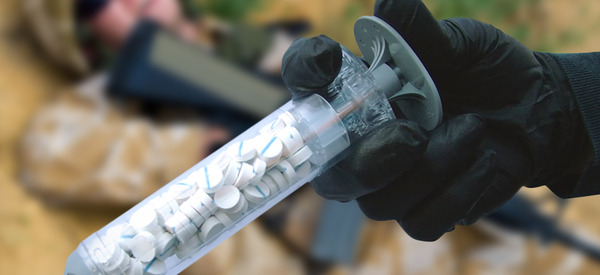in Industry, Medtech News
Battlefield Portable Injector Devices
Severe bleeding is one of the primary causes of death for soldiers injured on the battlefield. Problems most often arise when a soldier is suffering from a junctional hemorrhage, which is bleeding from the areas at the junction of the trunk and its appendages. These areas of the body will not conform to regular tourniquets, because they do not fit to give the correct circumferential pressure where needed.
These areas also have much softer skin tissue, so injuries to the neck, groin and shoulder mean severe bleeding can be notoriously difficult to control when applying standard hospital practices out on the battlefield.
A fast clotting medical gauze, or even a tampon, would usually be packed into the wounded area, but studies have shown that this treatment is usually ineffective in stopping the bleed.
Solution #1 XStat Rapid Hemostasis System
A newly approved device created by RevMedX called the Xstat is a new solution for stopping gunshot and shrapnel wounds from bleeding out. Innovation was key to the creation of this injector device with the idea being based on the common expandable foam applicators that have been used in the DIY industry for decades. However instead of foam, its a sponge they use to stop the bleed.
Dr. Ken Gregory, a co-founder of RevMedX, was shopping at a store when he discovered a dried and compressed kitchen sponge, the type that you splash water onto and watch it open-up into a normal sized kitchen sponge. That was when he experienced a “Eureka moment”.
The Xstat device works by injecting a dose of tiny sponge-like discs into an open wound with a syringe. The sponges, which have been treated with an anti-hemorrhagic substance, expand to 10 times their size in seconds, both plugging the wound and providing much needed compression to junctional bleeding.
The FDA has just issued approval for the Xstat to be used by the United States military, but only for use on junctional areas of the body, otherwise a traditional tourniquet should be applied. The sponge discs are suitable for up to four hours use, which should allow enough time to transfer a wounded soldier to a battlefield surgeon.
Solution #2 Undergrad Developed Foam Injector System
Undergrad students at Johns Hopkins University have also been working on developing a portable injector device to help address this type of trauma for the last year. It’s a large plastic syringe that has two compartments, but instead of sponges, the device uses foam. The injector, which is still in the development phase, contains both polyol and a diisocyanate, which when mixed produce a polyurethane foam. The foam enters the wound and then hardens helping to staunch the bleed.
One of the surgeons sponsoring the undergrads, Paul D. Danielson, a medical director for paediatric surgery, said the students’ new foam injector device looks promising, even though it’s still at the prototype stage:
“I don’t think it’s pie in the sky at all,” he said. “I think it’s a very viable solution to a problem that’s been plaguing us on the battlefield.”









